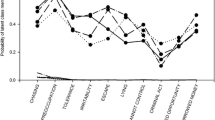Abstract
The purpose of this study was to compare the prevalence rate estimates and congruence in classification status derived from two popular measures of adolescent gambling (SOGS-RA and MAGS-7). Adolescents from three states (Alabama, Mississippi, and Oregon) completed an anonymous questionnaire (n=1846 high school students total). Results indicate that the prevalence of probable adolescent pathological gambling varied both as a function of instrument and cut-off point utilized for classification (range 1.7%–8.2%). Classification groups (non-problem, at-risk, and problem gamblers) generated by both instruments were found to be associated with reports of gambling frequency, amount of money lost in one gambling occasion, and parental gambling problems. However, concern was raised because the MAGS-7 and the SOGS-RA had little congruence in their three-group classification decisions for specific individuals (e.g., only 20.5% agreement for problem gamblers). To improve clinical utility, an empirical case was made for using the SOGS-RA to generate a fourth group of adolescent gamblers, which we labeled “probable pathological gamblers” (SOGS-RA ≥ 6). This group was differentiated from the remaining gambling groups on all the validity indices. The implications and limitations of these findings, as well as future directions, are discussed.
Similar content being viewed by others
REFERENCES
American Psychiatric Association (APA) (1994). Diagnostic and statistical manual of mental disorders (Fourth edition). Washington, DC: APA.
Derevensky, J.L., & Gupta, R. (2000). Prevalence estimates of adolescent gambling: A comparison of the SOGS-RA, DSM-IV-J, and the GA 20 questions. Journal of Gambling Studies, 16(2/3), 227–251.
Derevensky, J.L., Gupta, R., & Cioppa, G.D. (1996). A developmental perspective of gambling behavior in children and adolescents. Journal of Gambling Studies, 12, 49–66.
Govoni, R., Rupcich, N., & Frisch, G.R. (1996). Gambling behavior of adolescent gamblers. Journal of Gambling Studies, 12, 305–317.
Griffiths, M., & Wood, R.T.A. (2000). Risk factors in adolescence: The case of gambling, video-game playing, and the internet. Journal of Gambling Studies, 16(2/3), 199–225.
Hraba, J., & Lee, G. (1996). Gender, gambling, and problem gambling. Journal of Gambling Studies, 12, 83–101.
Jacobs, D.F. (1989). Illegal and undocumented: A review of teenage gambling and the plight of children of problem gamblers in America. In H. J. Shaffer, S. Stein, B. Gambino, & T. Cummings (Eds.), Compulsive gambling: Theory, research, and practice (pp. 249–292). Lexington, MA: Lexington Books.
Jacobs, D. F. (2000). Juvenile gambling in North America: An analysis of long-term trends and future prospects. Journal of Gambling Studies, 16, 119–152.
Jackson, D.N. (1976). Jackson personality inventory manual. Port Huron, MI: Research Psychologists Press.
Johnston, L.D., O'Malley, P.M., & Bachman, J.G. (1993). National survey results on drug use from monitoring the future study, 1975–1992. NIH Publication 93–3597. Washington, DC: US Government Printing Office.
Ladouceur, R., Bouchard, C., Rheaume, N., Jacques, C., Ferland, F., Leblond, J., & Walker, M. (2000). Is the SOGS an accurate measure of pathological gambling among children, adoles-cents, and adults? Journal of Gambling Studies, 16, 1–21.
Lesieur, H.R., & Blume, S.B. (1987). The South Oaks gambling screen (SOGS): A new instrument for the identification of pathological gamblers. American Journal of Psychiatry, 144, 1184–1188.
Lesieur, H.R., & Klein, R. (1987). Pathological gambling among high school students. Addictive Behaviors, 12, 129–135.
National Research Council (1999). Pathological gambling: A critical review. Washington, DC: National Academy Press.
Shaffer, H.J., & Hall, M.N. (1996). Estimating the prevalence of adolescent gambling disorders: A quantitative synthesis and guide toward standard gambling nomenclature. Journal of Gambling Studies, 12, 193–214.
Shaffer, H.J., Hall, M.N., & Vander Bilt, J. (1997). Estimating the prevalence of disordered gambling in the United States and Canada: A meta-analysis. Project funded by the National Center for Responsible Gambling. Kansas City, MO.
Shaffer, H.J., LaBrie, R., Scanlan, K.M., & Cummings, T.N. (1994). Pathological gambling among adolescents: Massachusetts adolescent gambling screen (MAGS). Journal of Gambling Studies, 10, 339–362.
Winters, K.C., & Anderson, N. (2000). Gambling involvement and drug use among adolescents. Journal of Gambling Studies, 16(2/3), 175–198.
Winters, K.C., Bengston, P., Dorr, D., & Stinchfield, R. (1998). Prevalence and risk factors of problem gambling among college students. Psychology of Addictive Behaviors, 12, 127–135.
Winters, K.C., Stinchfield, R.D., & Fulkerson, J. (1993). Toward the development of an adolescent gambling problem severity scale. Journal of Gambling Studies, 9, 63–84.
Winters, K.C., Stinchfield, R.D., & Kim, L.G. (1995). Monitoring adolescent gambling in Minnesota. Journal of Gambling Studies, 11, 165–183.
Author information
Authors and Affiliations
Rights and permissions
About this article
Cite this article
Langhinrichsen-Rohling, J., Rohling, M.L., Rohde, P. et al. The SOGS-RA vs. the MAGS-7: Prevalence Estimates and Classification Congruence. J Gambl Stud 20, 259–281 (2004). https://doi.org/10.1023/B:JOGS.0000040279.26711.ef
Issue Date:
DOI: https://doi.org/10.1023/B:JOGS.0000040279.26711.ef




